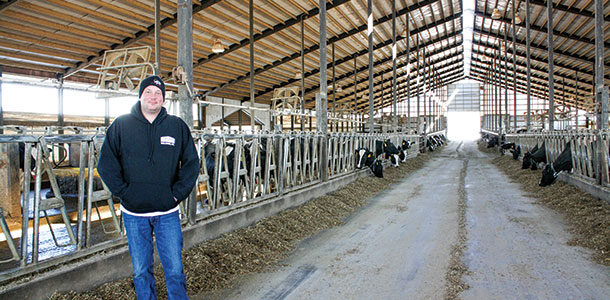After a brutal Midwestern winter, it’s time to start thinking spring. Mark Zinke, Zinke Dairy Farms LLC, Brownsville, Wisconsin, is changing gears to prepare for the warmer weather that is sure to come. To keep his 550-cow milking herd cool, he cleans fans and checks belt tension and bearings.
He also inspects his soaker lines, looking for nozzles that may have been damaged by cows or skid steers. Zinke plans to enhance his heat abatement efforts this year by implementing a positive pressure supplemental ventilation system in his holding pen.
Spring tune-up tips for curtains
• Replace and repair damaged curtains. With winter beginning to subside, now is the time to take down curtains for repairs and replacements and still have them back in place before summer arrives. Temperate springtime weather means your cows will not be suffering from cold or heat stress while the curtains are down.
• Optimize air flow and fresh air. Along with springtime comes temperature fluctuations that may range from below freezing to above 70ºF. A good ventilation system will allow you to optimize both air flow and fresh air despite the ups and downs of the outside temperature. One way to achieve this is with a split curtain system. Opening a few inches along the top will bring fresh air in without creating a draft.
• Schedule maintenance during the downtime for new construction. Avoid the waiting list by calling your curtain service provider and setting a date for a springtime maintenance check or replacement curtains now. As new building projects break ground in the summer and fall, it could be difficult to get prompt service during those times, so take advantage of the slower season.
Also, performing a maintenance check after the first major spring warm-up can be helpful in catching electrical shortages or other malfunctions that may have occurred from freezing and thawing.
— Tips provided by Development Resources of Iowa/Roll-O-Matic Curtains
Spring tune-up tips for fans and ventilation systems
• Wash fans. By cleaning off dust and debris with high-pressure water and soap or steam, fans will run better with less friction. A good rule of thumb is to wash fans when the temperature is consistently above freezing at night.
• Inspect fans visually . Look for worn pulleys, especially if they have not been replaced in the last four to five years. Check fan blades for cracks.
• Grease ball bearings . One springtime greasing is generally enough for the year. Two to three pumps from a hand grease gun is all you need. Overgreasing can actually cause seal damage.
— Tips provided by Wes Dorner, Dorner Equipment Sales and Services LLC
Spring tune-up tips for soaker cooling systems
• Flush and clean all filters. Replace filter screens if needed.
• Re-install the electric solenoid valve assemblies. These should have been taken down in the fall and stored where they would not freeze and crack. If they were left in place, be sure to check and test for possible cracks and replace as needed.
• Check all wires to make sure none were damaged over the winter. Replace any damaged transformers or temperature sensors.
• Flush the distribution lines. Usually, the lines are drained and left open during the winter. Dust and debris can blow into the line and cause problems with plugged spray tips when the system is first started again. You can eliminate most or all of these issues if you flush each line thoroughly before closing the drain valve and charging the line.
• Turn the system on. Don’t wait until the first 90ºF day to test the system. Test and activate the system as soon as freezing temperatures are safely behind us. The controller will only activate the system when the temperature reaches the set point, so there is no need to worry about wasting water.
— Tips provided by Dick Bonner, Edstrom, Inc. PD

Peggy Coffeen
Editor
Progressive Dairyman











